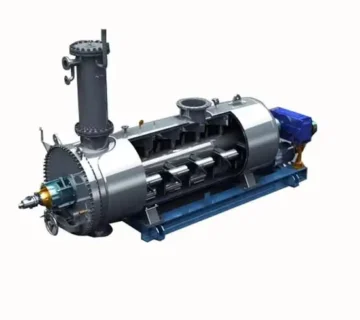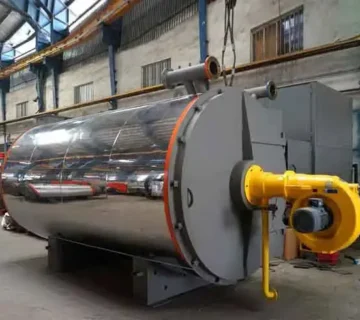Rendering Cooker for Slaughterhouse Waste: A Revolution in Meat Industry Waste Management
Introduction
The meat industry produces a significant amount of waste annually, which requires proper management and recycling. Waste materials such as bones, fat, skin, and inedible tissues can easily be transformed into products like meat meal, industrial fats, and even fertilizers. One of the most effective and widely used pieces of equipment in this field is the Rendering Cooker for Slaughterhouse Waste. These cookers, using a special thermal process, transform animal waste into recyclable products that are crucial both for reducing waste and optimizing resource consumption across various industries.
The Working Process of a Rendering Cooker
A rendering cooker is a machine that uses heat to convert animal waste into usable products. The cooking process involves heating the waste to a specific temperature, which breaks down organic matter and separates fats and proteins. This process not only helps reduce the volume of waste but also produces valuable byproducts with commercial value.

Advantages of Rendering Cookers
- Environmental Waste Reduction:
The use of rendering cookers effectively prevents the disposal of animal waste and stops its transformation into environmentally harmful materials. This reduces the negative impacts of waste on water, soil, and air. - Valuable Resource Recovery:
Animal waste such as bones, fat, and proteins can be converted into products like meat meal, industrial fats, and even pharmaceutical products. These products are mainly used in animal feed industries, cosmetics, and even in the production of biofuels. - Cost Reduction and Energy Optimization:
Modern rendering cookers optimize energy consumption, reducing the costs associated with waste disposal and processing.
Applications of Rendering Cookers in Various Industries
Rendering cookers are used not only in livestock and poultry slaughterhouses but also in industries such as fish processing and meat meal production. These cookers are considered one of the most effective and efficient pieces of equipment in industries dealing with large amounts of waste.

- Rendering Cookers in the Fish Industry:
In industries that deal with fish processing and seafood production, waste such as fish skin, bones, and inedible tissues is generated. These wastes can be converted into fish meal and fish oil using rendering cookers. - Meat Meal Production from Waste:
One of the primary products made from slaughterhouse waste is meat meal. This product is used as animal feed and has a high nutritional value due to its high protein content. - Use in Biofuel Industries:
Some of the fats produced during the rendering process can be used as raw materials for the production of biofuels, helping to reduce dependency on fossil fuels and greenhouse gas emissions.
Price of Rendering Cookers
The price of a rendering cooker depends on factors such as the capacity of the device, the type of materials used in its construction, and the technologies integrated into the device. Higher-capacity cookers with advanced technologies are usually more expensive but are considered long-term investments due to their high efficiency and energy savings.
Factors Affecting Price:
- Capacity: The larger the capacity, the higher the price. Large-capacity cookers are suitable for large industrial slaughterhouses.
- Energy Consumption: Cookers that utilize modern technology to reduce energy consumption are often more expensive, but they help reduce operational costs in the long run.

The Future of Rendering Cookers in the Industry
With increasing demand for efficient waste management and the need to produce byproducts from waste, rendering cookers are becoming a key piece of equipment in the meat and food processing industries. Given the growing importance of environmental issues and diminishing natural resources, this technology is expected to see significant growth in the near future.
History of Rendering Cookers in the Slaughter Industry
Rendering cookers have evolved from older waste management methods into modern, efficient systems. This section could explore the historical development of rendering cookers and how they have replaced traditional methods of waste management.
Rendering Cookers for Use in Farms and Poultry Farms
Rendering cookers are not only used in large slaughterhouses but also in smaller farms and poultry operations, where they help recycle waste and produce animal feed.
Innovations and Modern Technologies in Rendering Cookers
Introducing modern technologies such as automatic control systems, energy optimization, and high-heat-resistant materials can extend the article. It could also highlight new smart systems that have been integrated into modern rendering cookers.
Comparison of Rendering Cookers with Other Industrial Recycling Systems
This section could compare rendering cookers with other common methods of waste recycling, such as waste storage, incineration, or composting, and explain the advantages of this system over others.
Challenges and Issues with Rendering Cookers
This section could address the problems and challenges that may arise when using rendering cookers, such as maintenance issues, repair costs, and potential hazards if these devices are misused.
The Role of Rendering Cookers in Sustainable and Environmental Economics
Rendering cookers play a crucial role in reducing waste and preserving natural resources. This section could discuss the positive impact of these devices on the environment and their contribution to reducing greenhouse gas emissions.
Meat Powder Production Process in Slaughterhouse Waste Cooker
The cooker uses direct or indirect heat (steam or hot oil) to convert animal and poultry waste into meat powder. The process involves drying, grinding, and removing moisture and unpleasant odors.
Advantages of Using Waste Cookers in Livestock and Poultry Industries
It turns inedible waste into valuable products like meat powder, a rich source of protein for animal feed.
Difference Between Waste Cookers and Other Recycling Methods
Compared to methods like burial or incineration, waste cookers are more efficient as they turn waste into valuable products instead of destroying it.
Role of Waste Cookers in Improving Environmental Quality
The cooker reduces environmental pollution caused by burying or burning slaughterhouse waste, helping to preserve the environment.
Guide to Choosing a Waste Cooker for Different Businesses
Factors like production capacity, type of waste, and processing needs should be considered when selecting a cooker.
How to Maintain and Prolong the Lifespan of the Cooker
Regular maintenance, timely replacement of worn-out parts, and checking the heating and electrical systems ensure the longevity of the cooker.
Comparison of Direct and Indirect Steam Waste Cookers
In direct steam cookers, heat is transferred directly to the waste, whereas in indirect steam cookers, heat is transferred via steam or hot oil. Each method has its pros and cons.
Impact of Using Meat Powder in Livestock and Poultry Feed
Meat powder is rich in protein and serves as a valuable nutritional source in animal feed.
Dryer, Grinder, Cyclone, Condenser, Vacuum Pump, and Treatment Pool
Auxiliary equipment like dryers and grinders are essential for improving the waste-to-meat powder conversion process, while cyclones and condensers help control odors and enhance the final product’s quality. The vacuum pump reduces pressure and improves cooker efficiency, and the treatment pool is used for water purification and pollution control.
Questions and Answers (Q&A)
1. Why choose the slaughterhouse waste cooker from “Niro Bokhar Araz”?
Our boilers meet CE European standards, DIN German standards, and the Iranian national standard, ensuring optimal quality and performance.
2. What materials can the slaughterhouse waste cooker process?
It converts animal and poultry waste like blood, feathers, and meat scraps into usable meat powder and protein.
3. What type of heating is used in the cooker?
Our boilers operate with three heating methods: direct heat, indirect steam, and hot oil.
4. What are the capacities of the waste cookers?
Capacities range from 3.5 tons to 7 tons, depending on customer needs.
5. What materials are used in the boiler construction?
All materials are made from heat-resistant plates and tubes according to DIN standards, ensuring resistance to heat and pressure.
6. How is the cooker insulated?
It is insulated using rock wool and stainless steel or galvanized cladding to prevent energy loss.
7. How long does the process of converting waste to meat powder take?
The process typically takes between 5 to 6 hours.
8. Does the cooker require special maintenance?
Yes, with a long central shaft and replaceable bearings, maintenance is easier and prolongs the cooker’s lifespan.
9. Are there any auxiliary equipment available with the cooker?
Yes, equipment like dryers, grinders, cyclones, condensers, vacuum pumps, and treatment pools are available to enhance the process.
10. Can these cookers be used in other industries?
Yes, they can be used in poultry and animal industries, as well as protein processing.
11. Are there special welding techniques used?
All welding is done according to WPS and PQR standards by certified professional welders.
12. How does the cooker contribute to environmental improvement?
By converting waste into valuable materials, it reduces waste pollution and helps protect the environment.
13. How does the cooker reduce unpleasant odors in slaughterhouses?
Advanced systems like condensers are used to minimize odors in the working environment.
14. How safe are the waste cookers?
Our cookers are designed according to global safety standards and undergo rigorous quality checks.
15. Do you offer after-sales services?
Yes, we offer a 10-year warranty and 20 years of after-sales services.
Conclusion
The use of rendering cookers not only helps reduce waste and protect the environment but also leads to the production of value-added products. By utilizing this technology, meat and slaughter industries can effectively reduce costs and increase their efficiency.




